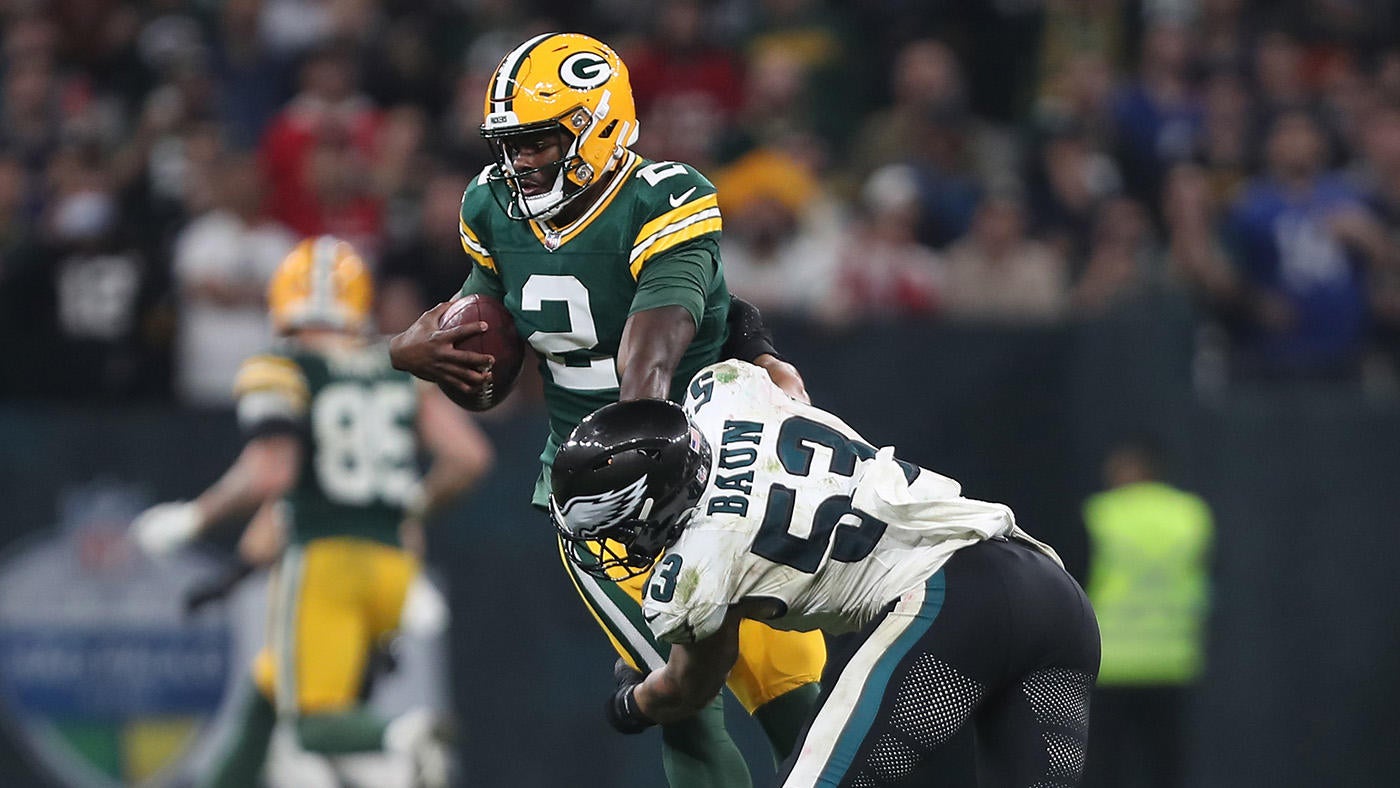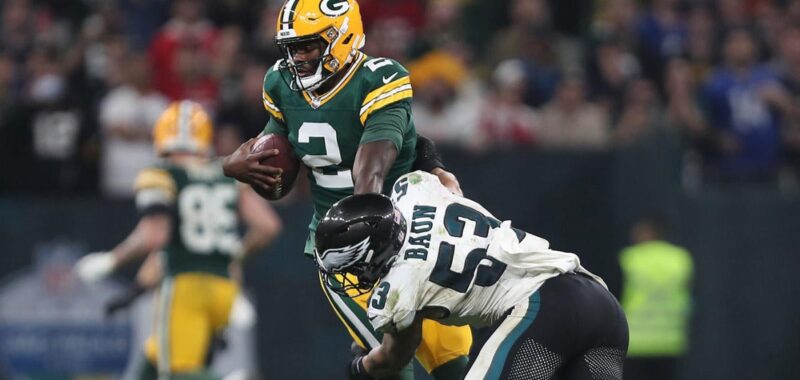
The Packers have famously enjoyed a seamless Brett Favre to Aaron Rodgers to Jordan Love quarterback lineage now for more than 30 years, and while present-day starter Malik Willis is simply and unequivocally a stand-in for Love while his knee recovers, it’s time to evaluate what he’ll bring to the field as Green Bay’s spot starter over the next month, especially because the Packers traded for him in August.
Willis was a third-round pick by the Titans in 2022 out of Liberty, despite being rumored throughout the draft season to be selected in the first round. After sitting behind Ryan Tannehill as a rookie and Will Levis in 2023, he was then entrenched in a backup battle with veteran Mason Rudolph — who has a markedly different skill set than Willis — before the trade.
Willis comes with unadulterated athleticism, a live arm, and general rawness at the quarterback position. He’s only 25 and has attempted 67 regular-season passes, with 61 of said attempts coming as a rookie in 2022.
But he has demonstrated signs of development in each of the past two preseasons, and I’ll highlight his performances from the 2024 preseason here. Sensible, because it’s the most recent time we’ve seen him play.
I wouldn’t characterize Willis’ arm as elite, but it’s probably near the bottom of the tier directly below the likes of Patrick Mahomes, Josh Allen, Anthony Richardson and Co. He can really spin the football.
Check the velocity, trajectory, and overall placement on this 35-yard touchdown in the preseason against the Saints.
Nearly 45 yards on a line, with just enough arc to track over the cornerback in coverage, and it arrived before the deep middle safety could make a play on the football. And those type of throws, with the velocity cranked to the max, are littered all across his film, to all levels of the field. And Willis has always had the fastball locked and loaded. If anything, that touchdown in New Orleans was one of the few hints he’s added touch to his throwing repertoire as he’s gotten more NFL experience.
Now to a negative. Sacks. One of the main gripes with Willis as a prospect was his propensity to get tackled behind the line of scrimmage It happened 30 times in his final season at Liberty and was likely a factor in his perceived “fall” to the third round of the draft.
Like essentially all the exemplary athletes we’ve seen pour into the NFL from the collegiate ranks at unprecedented rates in recent years, Willis often tries to generate the spectacular play off-script if he doesn’t first like what he sees as a passer.
In that 2021 season for the Flames, Willis had an astronomically high 30.5% pressure-to-sack rate. It was a much more respectable 18.3% the year before and 26.0% for his collegiate career. For young-quarterback context, Jayden Daniels’ career 24.5% pressure-to-sack rate was discussed at length as a clear negative on his draft profile, although it was only 20.2% in his final season at LSU.
Caleb Williams’ was 19.4% in college and 23.2% in 2023 at USC.
In three preseasons with the Titans, Willis’ pressure-to-sack rate was 27.5%. For NFL perspective, in the 2023 regular season, only three qualifying quarterbacks had a pressure-to-sack rate higher than 30%, Tannehill (ironically), Daniel Jones and Tommy DeVito.
Check this sack against the Seahawks. He’s stuck in the pocket, unsure of where to go with the football.
Those type of sacks appear on Willis’ film reasonably often, however, in this case, I didn’t notice anyone particularly open.
Don’t get it twisted though, Willis is not purely a one-read quarterback without any feel for navigating the pocket and keeping his eyes elevated. He’s grown as a passer moving through reads. Subtle maneuverability away from pressure has become part of his game too, like he showed on his throw against the Seahawks in August.
Looks right, bounces left, looks left, comes back to his right, steps up, fires a rocket between the numbers of the intended receiver against air-tight coverage.
Willis’ play-to-play ball placement does need to improve, something true of most young quarterbacks. Here against the 49ers, he sees his receiver in the slot get tugged as he’s trying to break to the outside, but there’s some separation — by NFL standards — as the wideout surges in the direction of the right sideline. And Willis’ throw is slightly high and away. Falls incomplete.
Can’t have many of those during his starting audition in Green Bay.
Lastly, there’s what Willis brings to the field athletically, as a scrambler and designed runner. While shorter and/or stockier than some of the other truly dual-threat quarterbacks in the NFL — Willis is listed at 6-foot-1 and 225 pounds — there is very little shortage of burst, acceleration, and pure speed with the football in his hands.
And there’s no timidness in the open field.
Watch here, how he shrugs off a defender well behind the line, hits the turbos to get upfield, and finishes the 8-yard run with some power.
While having that type of talent isn’t a prerequisite to playing quarterback in the NFL, we all can now acknowledge it’s drifting closer to being a necessity after previously being considered a luxury.
Willis has plenty of designed-run experience too, mostly in college at Liberty. And this element of his game, in this Packers offense in particular, fascinates me more than anything regarding his traits. Why? Because Packers coach Matt LaFleur, one of the better play-designers and play-callers in football, has never had a quarterback with Willis’ mobility at his disposal.
In fact, expanding here, the Kyle Shanahan coaching tree has really never been able to work with a genuinely dual-threat athlete at the quarterback position. Well, there are a few exceptions. If we’re thinking back to the true originator of the system, Kyle’s dad Mike, he of course won back-to-back Super Bowls in the late 1990s with John Elway, a specimen as physically gifted as a runner as any quarterback of his time.
What about Robert Griffin III?! Oh yes, he’s the other exception, who entered the NFL 14 years after Elway retired. And what did Kyle do as RG3’s offensive coordinator? As a rookie, Shanahan got a league-high 8.1 yards per attempt, at nearly 66% completion, with a mere five interceptions along with 815 yards rushing at 6.5 yards per tote (which also led the NFL) out of a quarterback who we came to realize was an average backup at his very best outside of the Shanahan system.
Think about it — other than Elway and Griffin III, the Shanahan Tree with branches like Sean McVay, Zac Taylor, LaFleur, and Mike McDaniel have coached the likes of Jared Goff, Matthew Stafford, Matt Ryan (Kyle himself), Brock Purdy, Matt Schaub, Kirk Cousins, Joe Burrow, Tua Tagovailoa, Nick Mullens, Sam Darnold, C.J. Stroud, and twilight-of-his-career Rodgers, who was never a legitimate dual-threat weapon but always rocked on the move as a thrower and improviser.
Therefore, we really don’t know what wrinkles LaFleur’s system can incorporate when the quarterback is a serious threat carrying the football. Heck, maybe the Shanahan system is averse to mobile quarterbacks with high-level rushing talent, the latter of which Willis can absolutely provide.
That zone-read section of the Shanahan playbook LaFleur runs — and has certainly added his own components to throughout the years — is dusty. Hasn’t been opened since Robert Griffin III was the starter in Washington in 2013.
Given Willis is essentially sized like a large running back, there’s an inside, between-the-tackles aspect he can add to the run game.
In his three preseasons with the Titans, Willis toted the rock 47 times for 390 yards — that’s 8.3 yards per! — with two scores and no fumbles. Of course, as many of the rookie quarterbacks discovered in Week 1, the regular season is a completely different animal than exhibition games in August.
But Willis did all one can do to in the preseason to suggest he’s at the very least worthy of carrying the football in games that count, and it’ll be fascinating to monitor how much LaFleur attempts to accentuate Willis’ natural athleticism as an extension of Green Bay’s ground attack.
Given the diverse array of weapons at his disposal, quality offensive line, and LaFleur’s time-tested scheme that has a proven track record of either reinvigorating elder quarterbacks or developing youthful ones, Willis will be in an ecosystem conducive to success, even in this short opportunity as the Packers starting quarterback.
Can he continue to develop mentally, mostly operating within structure? And will LaFleur tap into Willis’ plus athletic gifts?
If the answer to both those questions is yes, the Packers will be well on their way to yet another textbook quarterback developmental process, but this time it’ll be fast-tracked.

